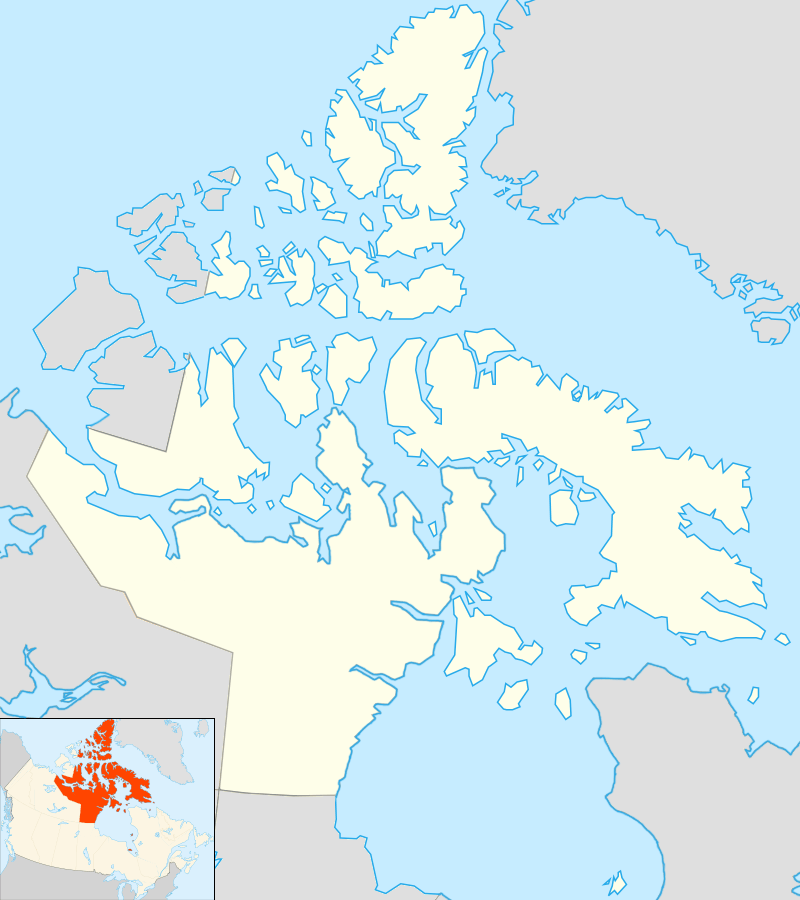Angikuni Lake
| Angikuni Lake | |
|---|---|
|
Angikuni Lake, July 2014 | |
 Angikuni Lake Location in Nunavut | |
| Location | Kivalliq Region, Nunavut |
| Coordinates | 62°12′N 99°59′W / 62.200°N 99.983°WCoordinates: 62°12′N 99°59′W / 62.200°N 99.983°W |
| Primary inflows | Kazan River |
| Primary outflows | Kazan River |
| Basin countries | Canada |
| Surface area | 510 km2 (197 sq mi) |
| Surface elevation | 257 m (843 ft) |
| Islands | Many |
| Settlements | uninhabited |
Angikuni Lake (variant: Lake Anjikuni)[1] is a lake in Kivalliq Region, Nunavut, Canada. It is one of several lakes located along the Kazan River; Ennadai Lake is to the south and Yathkyed Lake is to the north.
Geography
The lake's shore is notable for rocky outcroppings of the Precambrian Shield, being part of the Hearne Domain, Western Churchill province of the Churchill Craton.
Fauna
Barren-ground Caribou migrate through the area. The lake contains Lake trout, Northern pike, and Arctic grayling.
Ethnography
During his 1948 trip, Canadian explorer Farley Mowat arrived at Angikuni Lake, then part of the Northwest Territories, and found a cairn constructed in a fashion not normally used by area Inuit. It contained pieces of a hardwood flattened box with dovetailed corners. Mowat, knowing that only one other European explorer, Samuel Hearne, had been in this region previously (in 1770), speculated that the monument was built by Francis Crozier, who, as a member of the lost expedition originally led by Sir John Franklin, vanished in 1848 during the ill-fated search for the Northwest Passage. (Woodman, 1991, p. 317)
Myth of the vanishing village
In 1930, a newsman in The Pas, Manitoba, reported on a small Inuit village right off of Lake Angikuni. The village had always welcomed the fur trappers who passed through occasionally. But in 1930 Joe Labelle, a fur trapper well known in the village, found that all the villagers had gone. He found unfinished shirts that still had needles in them and food hanging over fire pits and therefore concluded that the villagers had left suddenly. Even more disturbing, he found seven sled dogs dead from starvation and a grave that had been dug up. Labelle knew that an animal could not have been responsible because the stones circling the grave were undisturbed. He reported this to the Royal Canadian Mounted Police (Kelleher refers to them using the anachronism North-West Mounted Police), who conducted a search for the missing people; no one was ever found.
Such is the story as it appears in Frank Edwards's 1959 book Stranger than Science; other versions appear in Whitley Strieber's science fiction novel Majestic and Dean Koontz's horror novel Phantoms. The World's Greatest UFO Mysteries (presented as fact) has an even more detailed version, as do other websites and books, adding other standard details such as mysterious lights in the sky, empty graveyards, and over a thousand people missing. The earliest version of the story is found in the November 27, 1930, Danville Bee,[2] written by journalist Emmett E Kelleher. That article states that Joe Labelle found an empty Eskimo camp with 6 tents and that 25 men, women and children had vanished. It also contained a "photo" that was later found to be from 1909 and had nothing at all to do with the story. The incident appears to have been forgotten until referenced by Edwards's 1959 book.
The RCMP has since dismissed the case as an urban legend, claiming that the story originated in Frank Edwards' book. The RCMP also states, "It is also believed that such a large village would never have been possible in such a remote area."[3][lower-alpha 1] The RCMP states that it has no record of any unusual activity in the area.
The story was debunked by Brian Dunning in an episode of Skeptoid.[4]
External links
- Angikuni Lake at the Atlas of Canada
References
- ↑ Although the aforementioned book the RCMP references mentions just 30 people and one grave, at least the argument may refute some variants of the story that more than a thousand people had been vanished. After all, the earliest version of the story in the news article states that it was a village of 6 tents with 25 people.
- ↑ Freeman, Randy (2007). "Roswell North". uphere.ca. Archived from the original on February 2, 2012. Retrieved 2008-09-21.
- ↑ Kelleher, Emmett E. (1930-11-27). "Vanished Eskimo Tribe Gives North Mystery Stranger Than Fiction". The Bee (Danville, Va.). The Pas. Retrieved 2010-04-05.
- ↑ "Anjikuni". Archived from the original on 2014-03-04. Retrieved 2012-09-18. Royal Canadian Mounted Police Historical Notes
- ↑ The Vanishing Village of Angikuni (2013) Skeptoid.
- Frank Edwards (1 January 1959). Stranger than science. L. Stuart. 303 pages.
- Latta, Jeffrey Blair. The Franklin Conspiracy Cover-Up, Betrayal, and the Astonishing Secret Behind the Lost Arctic Expedition. Toronto: Hounslow Press, 2001. Excerpt from Google Books ISBN 0-88882-234-0
- Woodman, David C. Unravelling the Franklin Mystery Inuit Testimony. McGill-Queen's native and northern series, 5. Montreal: McGill-Queen's University Press, 1991. Excerpt from Google Books ISBN 0-7735-0936-4